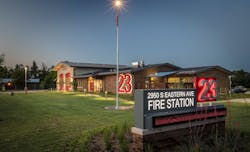Prototype Stations Can Save Money & Reinforce Department Branding
Last month, we wrote about re-using fire station designs and the problem with “stock” plans. However, we have found fire departments that design a “prototype” station for duplication on multiple sites. Benefits include the “brand” of a fire department in design and color schemes, similar floor plans for firefighters who are moved from station to station, and the possibility of saving money.
Jason Estes, senior associate with FGM Architects, shared that several Midwest suburban fire departments have opted for prototype plans, including Illinois fire departments in Plainfield, Frankfort, Lockport and Glenview.
“When you go through a town and see the same station again and again, you know it’s the same fire department,” said Estes, noting that it’s clearly part of the department’s branding.
OKC’s experience
One metro department, the Oklahoma City, OK, Fire Department (OKC Fire), has a fast-growing population that is straining the existing infrastructure. OKC Fire has an immediate need for multiple fire stations to keep up with the growth.
In 2007, Station 21 and 23 were identified in a bond proposal as needing to be replaced. However, there was a 10-year gap from the bond election to the start of the project and created cost issues from the beginning. Tony Davis, deputy chief, Support Services, explained that because construction costs had increased in the 10 years, the department decided to do both stations at the same time, hoping to save money.
Davis said the process initially began with the department sitting down to identify what they were looking for, before reaching out to Kirkpatrick Architecture Studio (KAS). The city conceived the idea of a prototype as a cost-saving method and requested the exact same floor plan for new stations. The stations were to be constructed simultaneously, sharing an identical base of 7,711 square feet, and use the same general contractor, W.L. McNatt.
Careful planning was required to stay within the budget. KAS offered alternate space concepts for potential staffing increases, while the city decided to add two additional sleeping rooms, another bathroom and a storage closet, bringing the final square footage to 8,496 square feet. Each station finished one month ahead of schedule.
“Kirkpatrick supplied some sketches, and these went back and forth until we felt we had what we were looking for and was within our budget,” Davis said. He added it was difficult to state how much money was saved by duplicating the stations and building both at the same time, but credit was given to “a very dedicated contractor.”
The department originally selected a metal building, but decided to go with traditional construction of light gauge framing for the living quarters, concrete masonry units and steel trusses for the bay and a masonry veneer. The buildings are sprinklered and meet all code requirements by the city.
Fire Station No. 21 is located in the middle of a commercial block near I-44, across the interstate from the previous location, which remained operational during construction. Fire Station No. 23 is built on a corner site in a combined industrial/residential area. The original station is next door and remained operational during construction.
The new stations feature two drive-through apparatus bays with MagnaGrip exhaust systems and accommodate a crew of six with a captain’s suite.
LED lighting throughout and highly efficient heating, ventilation and air conditioning (HVAC) systems provide long-term energy savings as well as comfort for the staff.
A bright red countertop on the kitchen island contrasts vividly with the wood of the cabinets and the stainless-steel appliances. A unique feature in the living quarters area is the pass-through lockers that are accessible both from the hallway and the sleep room.
One restroom is hardened and serves as a “Safe Room” during bad weather. A comfortable dayroom is adjacent to the kitchen, with a fully equipped exercise room down the hall. The watch room is just off the apparatus bay.
“These stations are esthetically pleasing to the eye,” Davis noted. “They are also very efficient. There isn’t any wasted space. They are not huge, but the open floor plan makes it feel bigger than it really is, and the firefighters really like the layout.”
Davis believes the prototype design was successful and said the same floor plan is being used for two additional stations under construction this year. A few adjustments are being made to Fire Station No. 29, currently under construction.
“We added lockers that could be utilized on either side of the wall in the officer’s quarters to allow personnel to get in their locker without having to disturb the person in their sleeping quarters,” Davis explained. “We also removed the utility refrigerator and added more cabinet space. Other than that, no significant changes were made.”
The design perspective
From a design standpoint, David Robinson, AIA, managing director at KAS, shared some of the challenges to a prototype station.
“The difficult part was designing in the flexibility to allow the design to accommodate different apparatus and crew size for different locations,” Robinson said. “To accomplish this, one alternate option was provided for sleep rooms for two additional firefighters and one for a third bay.”
He added: “Another difficult part was providing the stations with their own identities. The large station numerals aid in this. Additionally, by working with the City of Oklahoma City’s Office of Arts & Cultural Affairs, we incorporated the public arts funds as screening for the patio. So, the different screens at each station differentiate each.”
Is it necessary to identify the site location a station would be located on in order to do a prototype? According to Robinson, they designed the first two stations knowing the sites: “As the construction set was about to go out to bid, a hiring freeze necessitated removing one station and adding No. 23. Thus, No. 23 and No. 38 (currently under design) utilized a floor plan that was not informed by the site. Stations No. 23 and 38 benefitted from open and/or large sites, which allowed for the use of the plan as it was. A tighter site, or a site with access from the east side of the site, may have necessitated mirroring the plan or other modifications.”
When considering why more departments don’t opt for prototypes, Robinson explained that, “Most departments don’t have the funding or approval by their municipality or board to do multiple, identical stations simultaneously, though a lot of departments use past designs with the same architect to build on the successes of the built projects.”
Final thoughts
Similarity in styles, construction materials and colors are ways to “brand” a fire department. How do you brand your fire department? Let me know at [email protected].
About the Author
Janet A. Wilmoth
Special Projects Director
Janet Wilmoth grew up in a family of firefighters in a suburb of Chicago. Wilmoth, who is owner of Wilmoth Associates, worked with Fire Chief magazine for 27 years until it closed in 2013. She currently is the project director for Firehouse, overseeing the Station Design Conference.

